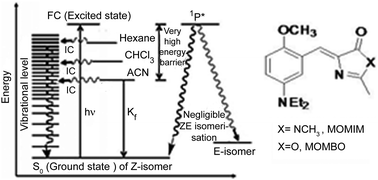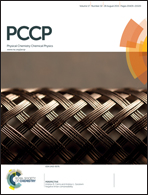Strong electron donation induced differential nonradiative decay pathways for para and meta GFP chromophore analogues†
Abstract
Z–E Isomerisation because of rotation around the exocyclic double bond (known as the τ-twist) and not any other internal conversion has been reported to be the major nonradiative decay channel for non-hydroxylic unconstrained para and meta GFP chromophore analogues. The equation Φf + 2ΦZE = 1 has been shown to hold well for both para and meta GFP chromophore analogues. If the above equation holds true, then upon reducing the extent of Z–E isomerisation (ΦZE), the fluorescence quantum yield (Φf) should increase. To probe the above proposition two sets of non-hydroxylic unconstrained para and meta GFP chromophore analogues were synthesized. Quite interestingly by introducing the strongly electron donating –NEt2 group to the benzenic moiety these para and meta GFP chromophore analogues were shown to exhibit differential optical behaviour w.r.t. the extent of the solvatochromic shift, Φf, ΦZE, and τf. For the first time it has been shown that the well accepted equation Φf + 2ΦZE = 1 does not hold at all for these non-hydroxylic unconstrained meta analogues. Although ΦZE has been shown to be <10%, Φf is much lower than the expected near unity value for these meta analogues. After detailed investigation into the nonradiative excited state decay channel, contrary to literature reports, energy gap law governed internal conversion and not Z–E isomerisation was shown to be the major nonradiative decay channel for these meta analogues. Two models are put forward to understand the differential optical behaviour of these para and meta GFP chromophore analogues. Support from X-ray crystal structures, NMR experiments, and computational calculations has also been provided.


 Please wait while we load your content...
Please wait while we load your content...